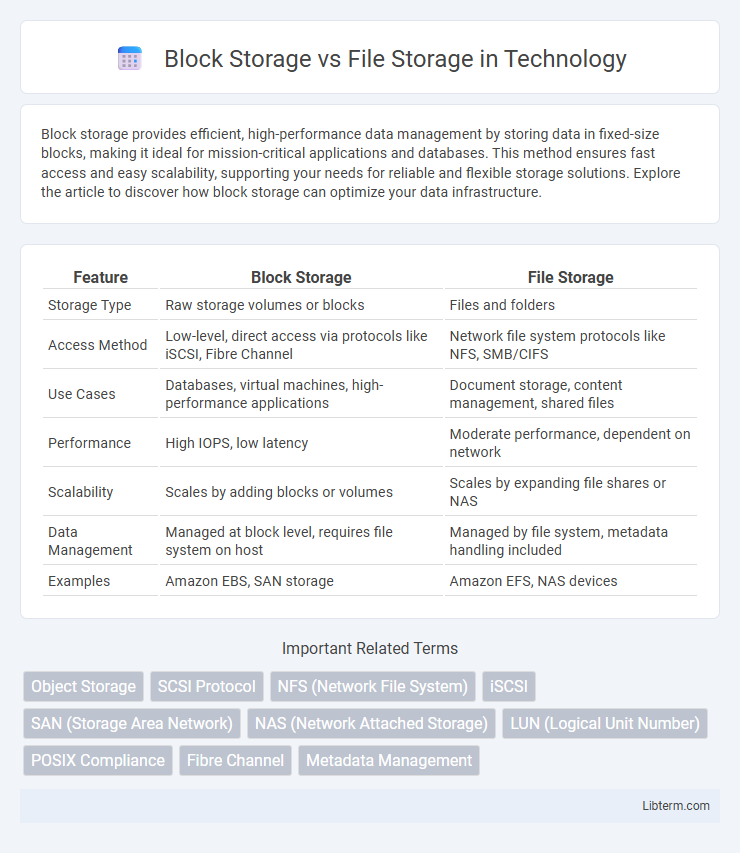Block storage provides efficient, high-performance data management by storing data in fixed-size blocks, making it ideal for mission-critical applications and databases. This method ensures fast access and easy scalability, supporting your needs for reliable and flexible storage solutions. Explore the article to discover how block storage can optimize your data infrastructure.
Table of Comparison
| Feature | Block Storage | File Storage |
|---|---|---|
| Storage Type | Raw storage volumes or blocks | Files and folders |
| Access Method | Low-level, direct access via protocols like iSCSI, Fibre Channel | Network file system protocols like NFS, SMB/CIFS |
| Use Cases | Databases, virtual machines, high-performance applications | Document storage, content management, shared files |
| Performance | High IOPS, low latency | Moderate performance, dependent on network |
| Scalability | Scales by adding blocks or volumes | Scales by expanding file shares or NAS |
| Data Management | Managed at block level, requires file system on host | Managed by file system, metadata handling included |
| Examples | Amazon EBS, SAN storage | Amazon EFS, NAS devices |
Introduction to Data Storage Solutions
Block storage organizes data into fixed-size blocks, making it ideal for databases and virtual machines that require high-performance and low-latency access. File storage manages data in a hierarchical structure using files and folders, suitable for shared storage environments and collaborative workflows. Choosing between block and file storage depends on specific application needs, performance requirements, and scalability considerations.
What is Block Storage?
Block storage divides data into fixed-size blocks, each with a unique identifier, enabling fast and efficient access at the hardware level. It is commonly used in SAN (Storage Area Network) environments to support databases, virtual machines, and enterprise applications requiring high performance and low latency. Unlike file storage, block storage lacks a hierarchical file system, giving applications direct access to storage volumes for flexible and scalable data management.
What is File Storage?
File Storage organizes data in a hierarchical structure of files and folders, making it ideal for managing unstructured data such as documents, images, and videos. It allows users to access and share files via network protocols like NFS or SMB, supporting collaborative environments. File Storage systems excel in use cases that require easy data sharing and direct file access, commonly used in content management and user directories.
Key Differences Between Block Storage and File Storage
Block storage divides data into fixed-size blocks, each with a unique identifier, enabling high-performance access and flexibility for databases and virtual machines. File storage organizes data as files within hierarchical directories, offering ease of use and compatibility for shared files and content management systems. Key differences include data access methods, performance levels, and use cases, with block storage excelling in speed and customization, while file storage prioritizes simplicity and file-level operations.
Performance Comparison: Block vs File Storage
Block storage delivers higher performance and lower latency by storing data in fixed-size blocks directly accessible by the operating system, ideal for databases and high-transaction applications. File storage manages data as files within a hierarchical structure, which introduces additional overhead and typically results in slower access speeds suitable for collaborative environments and content sharing. Benchmark tests consistently show block storage outperforming file storage in I/O operations per second (IOPS) and throughput, making it the preferred choice for performance-intensive workloads.
Use Cases for Block Storage
Block storage excels in high-performance applications such as databases, virtual machines, and enterprise-level transactional systems due to its ability to provide low latency and high input/output operations per second (IOPS). It is ideal for workloads requiring fast, granular access to raw storage blocks, enabling efficient file system management and high-speed data processing. Use cases for block storage include SAN environments, virtualization platforms, and systems demanding consistent performance and scalability.
Use Cases for File Storage
File storage is ideal for collaborative environments where files need to be accessed and shared by multiple users, such as in content management systems, document sharing platforms, and media libraries. It supports hierarchical directory structures and is commonly used for user home directories, shared network drives, and backups. File storage systems excel in scenarios requiring ease of file access, metadata support, and integration with operating system-level file handling.
Security Considerations in Block and File Storage
Block storage offers enhanced security through granular data management, enabling encryption at the block level and customizable access controls for individual blocks. File storage, while easier to manage due to hierarchical file systems, often relies on traditional permission models that may be less flexible against sophisticated threats. Enterprises prioritizing data isolation and encryption frequently prefer block storage solutions to mitigate risks associated with unauthorized access and data breaches.
Cost Implications: Block Storage vs File Storage
Block storage typically incurs higher costs due to its low-latency performance and flexibility in handling large databases and virtual machine file systems, making it suitable for enterprise applications requiring speed and reliability. File storage usually offers a more cost-effective solution for general-purpose use cases such as content management, collaboration, and backup, with easier scalability and management at the expense of slightly higher latency. Organizations must evaluate workload requirements and budget constraints to determine whether the higher expense of block storage's performance benefits outweigh the economical and administrative advantages of file storage.
Choosing the Right Storage Solution for Your Business
Block Storage offers high-performance, low-latency access ideal for databases and virtual machines, making it a preferred choice for businesses requiring fast, transactional data processing. File Storage provides a hierarchical structure suited for shared files and collaboration, benefiting organizations with extensive document management needs. Evaluating workloads, access patterns, and scalability requirements ensures choosing the right storage solution enhances efficiency and supports business growth.
Block Storage Infographic

 libterm.com
libterm.com